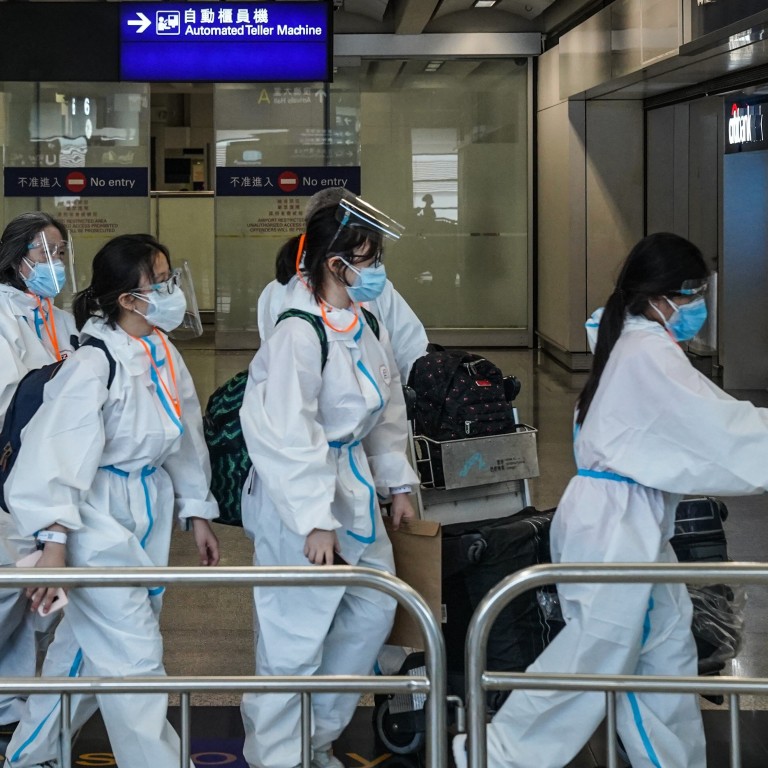
Coronavirus: infected passengers from Nepal may have sparked latest round of cases in Hong Kong, top virologists say
- The new virus strain found among latest local cases bears a close resemblance to those imported from Nepal, Dr Chuang Shuk-kwan of the Centre for Health Protection says
- ‘It is very likely that the cases from Nepal brought in the local infections,’ Professor Leo Poon of HKU says
Infected travellers from Nepal are “very likely” to have sparked the latest Covid-19 outbreak, adding to fears of a possible fourth wave in Hong Kong, top virologists have said, with a new coronavirus type found among city residents being almost identical to a strain in the South Asian country.
Hong Kong recently tamed a raging third wave of infections, with only a sporadic number of local cases reported over the last few weeks.
But 15 new infections linked to China Secret bar in Tsim Sha Tsui and more than 10 cases tied to a staycation holiday in Mui Wo have again put the city on edge.

On Wednesday, Dr Chuang Shuk-kwan, head of the Centre for Health Protection’s communicable disease branch, said an analysis of recent cases by the University of Hong Kong showed the virus strains were not similar to those found in previous rounds, such as from the Bun Kee restaurant cluster, which was widely believed to have started the third wave in late June.
Hong Kong bans Nepal Airlines as city records 11 new coronavirus cases
Pathogen strains found among patients at the disabled care home, the Home of Treasure, last month were also not similar to those in recent cases.
Instead, the new strain bore a close resemblance in its genetic code to those imported from Nepal, and had spread far and wide in the community since mid-October, infecting patients in Mui Wo, Tung Chung and Tai Po, the health official said.
Those [viral genomes] from Nepal are more than 99 per cent, sometimes even 100 per cent, similar to the local ones
Professor Leo Poon Lit-man, head of HKU’s public health laboratory sciences division in the faculty of medicine, confirmed the findings to the Post on Thursday.
Poon and his team sequenced the viral genome of samples from multiple infected travellers from Nepal, India, the United States, and European countries in recent weeks, and compared them with those collected from local patients who had acquired the virus recently.
“Those [viral genomes] from Nepal are more than 99 per cent, sometimes even 100 per cent, similar to the local ones,” he said.
The virologist said it was the task of the Centre for Health Protection – the agency responsible for contact tracing in the city – to conduct epidemiological research and determine the exact paths of transmission. “But it is very likely that the cases from Nepal [sparked] the local infections.”
Asked how the virus could have spread to the community from the travellers, Poon said transmissions could have taken place in the airport, at hotels during quarantine, or on the transport international arrivals took while heading to hotels.

Known as DG14G20B, the new strain also carries the genetic part of the notorious and highly transmissible D614G strain, which was widely believed to have become the dominant type and wreaked havoc across the world since May.
But whether the latest mutation would further strengthen the coronavirus and make it more severe and transmissible was yet to be seen, Poon said.
“This could be the start of the fourth wave in Hong Kong. But the most important thing we can do now is to maintain social distancing and adopt other measures to curb its spread,” he said.
Dr Gilman Siu Kit-hang, associate professor at Polytechnic University’s health, technology and informatics department, who also looked at the recent cases in a separate genome study, added the new coronavirus strains were also similar to the ones imported from India, which currently has the second-highest number of recorded infections worldwide.
According to official data, 29 infections were imported from Nepal since mid-September, while two close contacts were also infected locally. One of them, a 72-year-old woman, experienced Covid-19 symptoms despite returning a negative respiratory sample during her quarantine, and eventually infected her son and daughter-in-law after returning home.
HKU microbiologist Dr Ho Pak-leung said a 73-year-old patient, who had returned from Nepal on September 13, was only confirmed as infected on October 4, after ending his quarantine period. Two of his family members also tested positive later, as Ho believed this group was most likely to have spread the virus into the community.
Air India banned from entering Hong Kong for fourth time
Infectious disease specialist Dr Joseph Tsang Kay-yan said the government should ensure all people on quarantine underwent a second test for the virus, a requirement he said was not being followed strictly.
Nepal is among 15 countries deemed by the Hong Kong government as “very high risk” for Covid-19. Travellers from these countries must get a negative Covid-19 test result before departure, and must quarantine themselves at a local hotel for two weeks upon arrival.
Nepal Airlines was banned multiple times by the city’s health authorities for bringing in infected passengers. The latest ban on the airline started on Thursday and will last two weeks.
